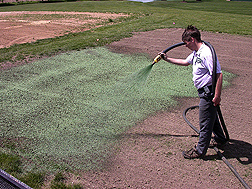This page has been archived and is being provided for reference purposes only. The page is no longer being updated, and therefore, links on the page may be invalid.
| Read the magazine story to find out more. |
|
|
Researchers Study Hydromulches with Guar Gum Substitutes
By Marcia Wood
January 21, 2014
Highway crews busily spraying a green coating on newly graded slopes may be working with a hydraulically applied mulch, or hydromulch. This temporary, porous layer can help protect newly sown seeds.
According to U. S. Department of Agriculture (USDA) plant physiologist Steven F. Vaughn, hydromulches typically contain water; a dye, so that crews can easily see where they've been; a mulch, such as wood fibers; and a binder, which is a compound that helps keep the mulch intact. In a series of laboratory tests, Vaughn and his colleagues have shown that half a dozen plant-derived compounds outperformed guar gum, a commonly used binder made by grinding beans of the guar plant into a powder. When water is added, the powder forms a viscous gum.
Importantly, the alternative binders may prove to be less expensive than guar gum, Vaughn notes.
Vaughn works at the National Center for Agricultural Utilization Research operated in Peoria, Ill., by USDA's Agricultural Research Service (ARS). ARS is the chief intramural scientific research agency of USDA.
The list of top-performing binders, documented in a 2013 scientific article in Industrial Crops and Products, includes xanthan gum, made by the bacterium Xanthomonas campestris, and gums extracted from seeds of two members of the mustard family, camelina and lesquerella.
Also making the list: a starch-based material, known as a high-amylose starch-lipid complex, that's made of cornstarch loosely bound to sodium palmitate, a fatty acid found in many everyday vegetable oils.
The panel of 10 compounds selected for the lab tests appears to be unique. And, although starch has been used commercially as a hydromulch binder, the high-amylose starch-lipid complexes, made with an eco-friendly method developed by Vaughn's ARS colleagues, apparently had not been previously lab-tested for this potential use.
Vaughn is now coordinating a series of outdoor tests as a follow-up to the indoor experiments. He collaborated in the research with ARS scientists Robert W. Behle, Mark A. Berhow, Steven C. Cermak, Roque L. Evangelista, George F. Fanta, Frederick C. Felker, and James A. Kenar, and with Edward Lee of HydroStraw, LLC.
Read more about this research in the January 2014 issue of Agricultural Research magazine.

